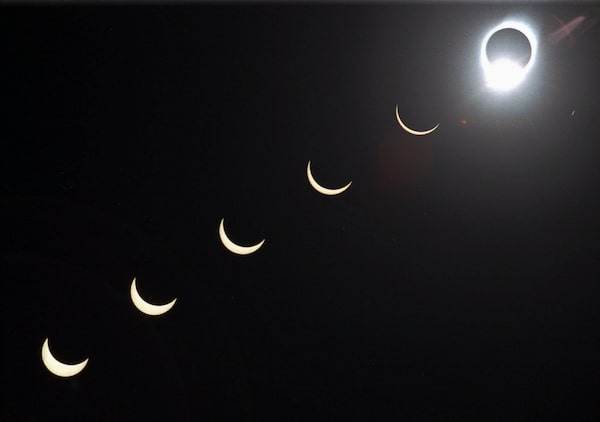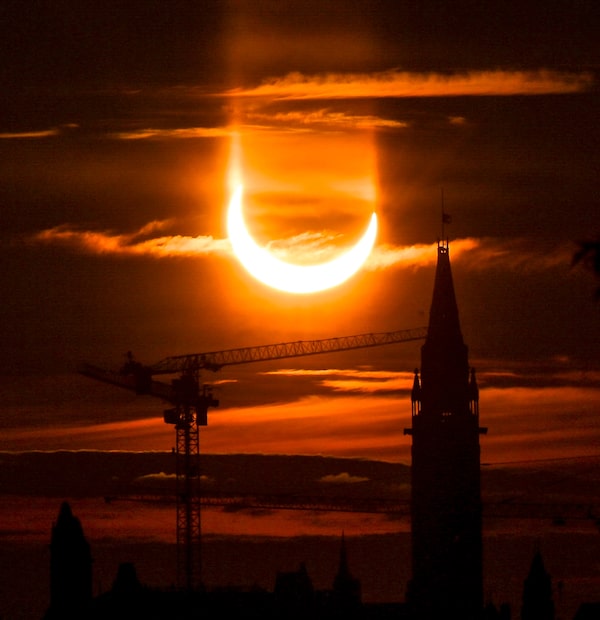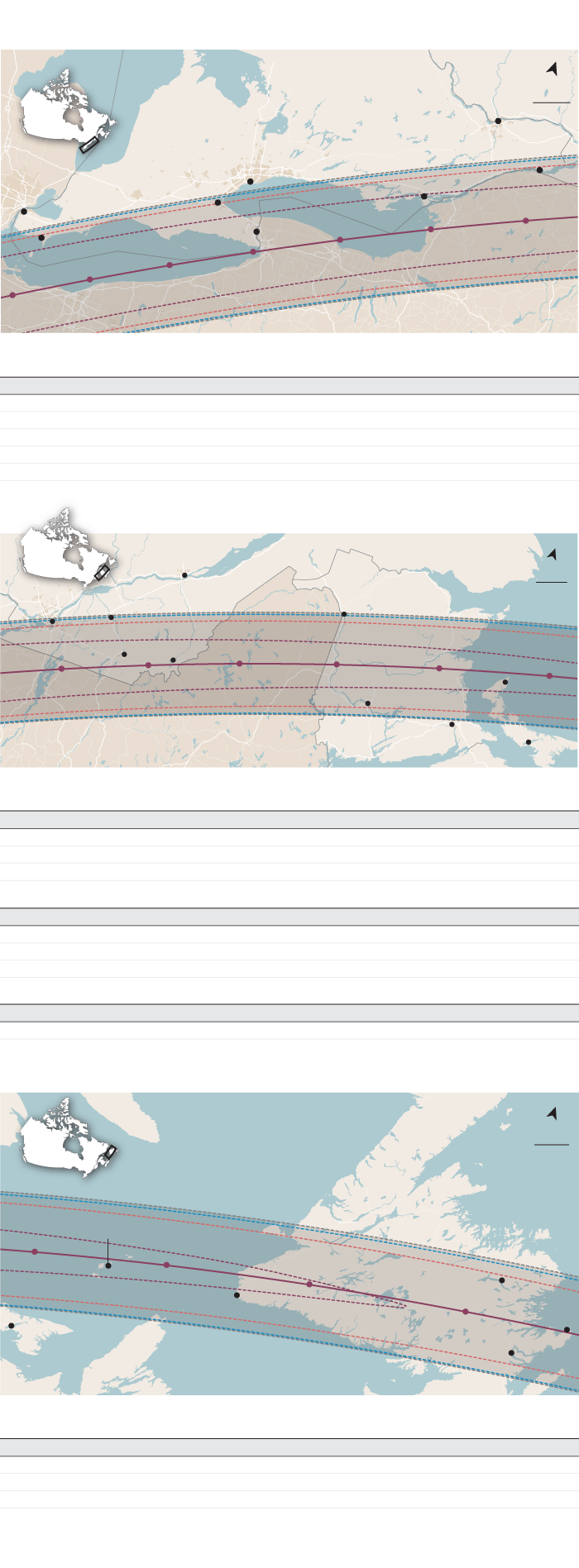
For North American eclipse watchers, this annular solar eclipse in San Antonio, Texas, last October was just a warm-up for the total eclipse coming up on April 8. In a total eclipse, the moon completely obscures the sun; in an annular eclipse, a ring of sunlight is still exposed because the moon is too far away from the Earth.Eric Gay/The Associated Press
Linda Besner is a writer based in Montreal.
It will begin, as far as I understand, like an ordinary sunset. The sunlight now flashing off the roof of a snow-covered shed visible out my window will weaken and take on the orange glow with which I’m familiar; I’ve seen sunsets before. But then – on April 8 at 3:26 p.m. Eastern Standard Time, for one minute and 25 seconds – I will stand in an unearthly world stripped of the colours I know.
“The grasses were wrong; they were platinum,” Annie Dillard wrote, of standing in the eerie darkness of the total solar eclipse of 1979. “Their every detail of stem, head, and blade shone lightless and artificially distinct as an art photographer’s platinum print.” On the hill where Ms. Dillard had gathered with other sky-gazers, people started screaming. To watch the sun sucked out of existence – leaving us improbably behind – is to ride the fragile vessels of our human bodies into the horizon of the dizzying cosmic scale.

Total solar eclipses, like this one seen from Cambodia in 1995, progress from thicker to thinner crescents before the sun is fully obscured.Richard Vogel/The Associated Press/The Associated Press
I am among the geographically elect: Only 0.5 per cent of the world’s population lives in the path of totality, that swath of Earth that will be plunged into silvery darkness. It’s startling to be reminded that, despite the way communication technologies have shrunk the globe, our physical position on its expanse is as determinative as ever. The enormity of the sun, and yet the specificity of the path of totality, remind me that we live on several scales at once. The “human scale” can be as small and literal as the fact that I need to climb up on my kitchen counter to reach my cupboards, and as grand and metaphorical as a recognition of universal human rights. We live private lives that, taken together, form the public sphere; we each fall asleep in a single spot, yet wake to the local effects of global news. If the eclipse is at once a cosmic and a hyperlocal event, the contemporary human experience is a Wonderland-ish picaresque of moment-to-moment swings between macro and micro scales.
Quiet region of Quebec in the path of totality prepares for thousands of solar eclipse visitors
A fun fact: We’re in the sun’s 15-minute neighbourhood. This spatial-temporal notion, beloved of urban planners and reviled by confused conspiracy theorists, suggests that a recipe for healthy communities is proximity: Residents should be able to travel easily around a relatively small geography to find what they need. It takes sunlight eight minutes to travel to our planet, at a speed of 300,000 kilometres a second. This easy strolling distance is what makes it possible for the Earth to support life. If a cosmic neighbourhood seems like a contradiction in terms, consider that “neighbourhood” is already a vexed concept. No one can quite agree on what defines it – whether hard geographical boundaries, visual aesthetic, ethnic or class commonalities, or simply a feeling.

Ottawans saw a stunning annular eclipse over the Peace Tower in 2021. This year, the city will only get a partial eclipse, though a drive to Cornwall will take viewers just to the edge of the path of totality.Sean Kilpatrick/The Canadian Press
Near and far are always relative terms. A total eclipse and a partial eclipse seem like they ought to be much the same thing, and yet – Annie Dillard again – ”seeing a partial eclipse bears the same relationship to seeing a total eclipse as kissing a man does to marrying him.” Those who just miss it may not even recognize how distant their experience is from the main event.
Opinion: What our souls can see in an eclipse’s darkness
Everyone, I think, now has at least one person in their life who inhabits the permanent penumbra of the American news cycle, glued to developments in storylines they can do little to affect. Most of life, of course, is always happening elsewhere, to other people. The amount that any one of us can experience firsthand will always be minuscule. But I think of a neighbourhood as a place that vouchsafes a glimpse of the contours of other people’s lives – an area small enough that we can’t help but know something about each other without necessarily being told. The best neighbourhoods are a jumble: old and new ideas and different modes of living mixed up together, so that to stand in one place is to keep a wide variety of experiences in sight.
In a 1766 painting by British artist Joseph Wright, a lecturer demonstrates the causes of eclipses using an orrery, a model solar system.Joseph Wright Gallery at Derby Museum and Art Gallery
Perspective, in art-historical terms, can be said to have narrowed in Western Europe after 1420. Filippo Brunelleschi’s invention of linear perspective – the system for representing three-dimensional objects on a two-dimensional plane by arranging them along orthogonal lines that meet at a central vanishing point – made it easier to fashion representations that look realistic. But mirroring life can be more complicated than simply recreating appearances. Medieval art of the preceding period, like the art of other cultural traditions, can seem surrealist; rather than serving a strictly mimetic purpose, scale and perspective illustrate a psychological and emotional reality. Figures that loom large in psychic space swell on the canvas. Tables might tilt to show important manuscripts being written; religious figures might dominate a composition, even when approaching from a distance. Because time had its own fluid scale, sequential episodes in a narrative might occupy the same pictorial space – medieval artists were painting a world created by an eternal God who saw everything, everywhere, all at once.
Where to see all the total solar eclipses for the rest of this decade
Today, we have something like a God’s-eye view available to us, and the harmonious rational lines of linear perspective may obscure more about our relationships with distant people and events than they reveal. What is far away does not feel small. The block of Montreal where I live is covered with graffiti expressing different perspectives on the destruction in Gaza, and disputing the meaning of events of 1948. Time and space feel collapsible, unmoored. At the same time, certain geographical realities remain stubbornly fixed; here and there are the difference between life and death.
When the eclipse sweeps across the city, I expect a crowd. I expect to be jammed together with people I don’t know, with whom I have little in common except that for this moment, we will witness something otherworldly together: a revelation we neither worked for nor deserve. A neighbourhood, in some definitions, is simply a space created by heightened social interactions. I lived in my previous Montreal neighbourhood for five years, and during the 2017 eclipse, visible only partially from my spot on the planet, I exchanged my only words with the people who lived in the apartment facing mine. Standing in the street together, we exchanged momentary gifts: They loaned me their welding goggles, and I loaned them the pinhole camera I had made out of a cereal box. For a moment, we saw into the far distance through each other’s eyes. The cosmic event passed by overhead. And then we all went back to our small and separate lives.
Map: Where Canadians can see the April 8 eclipse

(local times, p.m.)
ONT.
North
100 km
Toronto
Durations
30 seconds
U.S.
Hamilton
1 minute
Windsor
2 minutes
Niagara
Falls
3 minutes
Leamington
3:20
Central line
3:18
3:16
3:14 p.m.
(EDT)
Ottawa
Cornwall
Kingston
3:26
3:24
3:22 p.m.
(EDT)
PARTIAL
TOTAL
DURATION
PARTIAL
ECLIPSE
ECLIPSE
OF
ECLIPSE
BEGINS
BEGINS
TOTALITY
ENDS
Ontario
Leamington
1:58:39
3:13:43
2m 2s
4:28:04
Hamilton
2:03:56
3:18:12
1m 53s
4:31:12
Niagara Falls
2:04:53
3:18:20
3m 30s
4:32:00
Fort Erie
2:04:47
3:18:12
3m 44s
4:32:02
Kingston
2:09:32
3:22:16
3m 2s
4:34:28
Cornwall
2:12:35
3:25:01
2m 11s
4:35:58
North
Quebec
100 km
QUE.
Montreal
Lac-Mégantic
3:32
3:30
3:28 p.m.
(EDT)
PARTIAL
TOTAL
DURATION
PARTIAL
ECLIPSE
ECLIPSE
OF
ECLIPSE
BEGINS
BEGINS
TOTALITY
ENDS
Quebec
Montreal
2:14:29
3:26:55
1m 17s
4:36:52
Drummondville
2:16:07
3:28:32
35s
4:37:40
Sherbrooke
2:16:37
3:27:43
3m 25s
4:38:16
Lac-Mégantic
2:18:01
3:28:47
3m 27s
4:38:58
North
100 km
N.B.
Grand Falls
Les Îles-de-la-Madeleine
4:34 p.m.
(ADT)
4:36
4:40
Tignish
Fredericton
PEI
Moncton
Charlottetown
PARTIAL
TOTAL
DURATION
PARTIAL
ECLIPSE
ECLIPSE
OF
ECLIPSE
BEGINS
BEGINS
TOTALITY
ENDS
New Brunswick
Grand Falls
3:22:45
4:33:06
1m 27s
5:40:49
Hartland
3:22:43
4:32:24
3m 21s
5:43:13
Fredericton
3:23:43
4:33:50
2m 16s
5:41:55
Miramichi
3:25:27
4:34:24
3m 09s
5:42:15
Prince Edward Island
Tignish
3:27:12
4:35:45
3m 11s
5:43:10
Summerside
3:27:23
4:37:08
1m 04s
5:43:32
North
100 km
N.L.
Gander
5:14 p.m.
(NDT)
Bonavista
5:18
Clarenville
Channel-Port
Aux Basques
PARTIAL
TOTAL
DURATION
PARTIAL
ECLIPSE
ECLIPSE
OF
ECLIPSE
BEGINS
BEGINS
TOTALITY
ENDS
Newfoundland and Labrador
Channel-Port
4:02:52
5:09:59
2m 45s
6:15:26
Aux Basques
Gander
4:07:27
5:12:50
2m 13s
6:16:29
Clarenville
4:08:11
5:13:38
2m 31s
6:17:11
Bonavista
4:08:52
5:13:43
2m 53s
6:17:07
MURAT YÜKSELIR / THE GLOBE AND MAIL, SOURCE:
NASA; OPENSTREETMAP; FRED ESPENAK,
RASC OBSERVER’S HANDBOOK

(local times, p.m.)
ONT.
North
100 km
Toronto
Durations
30 seconds
U.S.
Hamilton
1 minute
Windsor
2 minutes
Niagara
Falls
3 minutes
Leamington
3:20
Central line
3:18
3:16
3:14 p.m.
(EDT)
Ottawa
Cornwall
Kingston
3:26
3:24
3:22 p.m.
(EDT)
PARTIAL
TOTAL
DURATION
PARTIAL
ECLIPSE
ECLIPSE
OF
ECLIPSE
BEGINS
BEGINS
TOTALITY
ENDS
Ontario
Leamington
1:58:39
3:13:43
2m 2s
4:28:04
Hamilton
2:03:56
3:18:12
1m 53s
4:31:12
Niagara Falls
2:04:53
3:18:20
3m 30s
4:32:00
Fort Erie
2:04:47
3:18:12
3m 44s
4:32:02
Kingston
2:09:32
3:22:16
3m 2s
4:34:28
Cornwall
2:12:35
3:25:01
2m 11s
4:35:58
North
Quebec
100 km
QUE.
Montreal
Lac-Mégantic
3:32
3:30
3:28 p.m.
(EDT)
PARTIAL
TOTAL
DURATION
PARTIAL
ECLIPSE
ECLIPSE
OF
ECLIPSE
BEGINS
BEGINS
TOTALITY
ENDS
Quebec
Montreal
2:14:29
3:26:55
1m 17s
4:36:52
Drummondville
2:16:07
3:28:32
35s
4:37:40
Sherbrooke
2:16:37
3:27:43
3m 25s
4:38:16
Lac-Mégantic
2:18:01
3:28:47
3m 27s
4:38:58
North
100 km
N.B.
Grand Falls
Les Îles-de-la-Madeleine
4:34 p.m.
(ADT)
4:36
4:40
Tignish
Fredericton
PEI
Moncton
Charlottetown
PARTIAL
TOTAL
DURATION
PARTIAL
ECLIPSE
ECLIPSE
OF
ECLIPSE
BEGINS
BEGINS
TOTALITY
ENDS
New Brunswick
Grand Falls
3:22:45
4:33:06
1m 27s
5:40:49
Hartland
3:22:43
4:32:24
3m 21s
5:43:13
Fredericton
3:23:43
4:33:50
2m 16s
5:41:55
Miramichi
3:25:27
4:34:24
3m 09s
5:42:15
Prince Edward Island
Tignish
3:27:12
4:35:45
3m 11s
5:43:10
Summerside
3:27:23
4:37:08
1m 04s
5:43:32
North
100 km
N.L.
Gander
5:14 p.m.
(NDT)
Bonavista
5:18
Clarenville
Channel-Port
Aux Basques
PARTIAL
TOTAL
DURATION
PARTIAL
ECLIPSE
ECLIPSE
OF
ECLIPSE
BEGINS
BEGINS
TOTALITY
ENDS
Newfoundland and Labrador
Channel-Port
4:02:52
5:09:59
2m 45s
6:15:26
Aux Basques
Gander
4:07:27
5:12:50
2m 13s
6:16:29
Clarenville
4:08:11
5:13:38
2m 31s
6:17:11
Bonavista
4:08:52
5:13:43
2m 53s
6:17:07
MURAT YÜKSELIR / THE GLOBE AND MAIL, SOURCE:
NASA; OPENSTREETMAP; FRED ESPENAK,
RASC OBSERVER’S HANDBOOK

(local times, p.m.)
North
50 km
CANADA
Ottawa
ONT.
Cornwall
Toronto
Durations
30 seconds
U.S.
Kingston
1 minute
Hamilton
Windsor
2 minutes
3 minutes
3:26
Niagara Falls
Leamington
3:24
3:22
3:20
Central line
3:18
3:16
3:14 p.m.
(EDT)
PARTIAL
TOTAL
PARTIAL
ECLIPSE
ECLIPSE
DURATION OF
ECLIPSE
BEGINS
BEGINS
TOTALITY
ENDS
Ontario
Leamington
1:58:39
3:13:43
2m 2s
4:28:04
Hamilton
2:03:56
3:18:12
1m 53s
4:31:12
Niagara Falls
2:04:53
3:18:20
3m 30s
4:32:00
Fort Erie
2:04:47
3:18:12
3m 44s
4:32:02
Kingston
2:09:32
3:22:16
3m 2s
4:34:28
Cornwall
2:12:35
3:25:01
2m 11s
4:35:58
North
Quebec
50 km
QUE.
N.B.
Montreal
Grand
Falls
Drummondville
Lac-Mégantic
Sherbrooke
3:32
4:34 p.m.
(AST)
3:30
4:36
3:28 p.m.
(EDT)
Tignish
Fredericton
PEI
Moncton
Charlottetown
PARTIAL
TOTAL
PARTIAL
ECLIPSE
ECLIPSE
DURATION OF
ECLIPSE
BEGINS
BEGINS
TOTALITY
ENDS
Quebec
Montreal
2:14:29
3:26:55
1m 17s
4:36:52
Drummondville
2:16:07
3:28:32
35s
4:37:40
Sherbrooke
2:16:37
3:27:43
3m 25s
4:38:16
Lac-Mégantic
2:18:01
3:28:47
3m 27s
4:38:58
New Brunswick
Grand Falls
3:22:45
4:33:06
1m 27s
5:40:49
Hartland
3:22:43
4:32:24
3m 21s
5:43:13
Fredericton
3:23:43
4:33:50
2m 16s
5:41:55
Miramichi
3:25:27
4:34:24
3m 09s
5:42:15
Prince Edward Island
Tignish
3:27:12
4:35:45
3m 11s
5:43:10
Summerside
3:27:23
4:37:08
1m 04s
5:43:32
North
50 km
Les Îles-de-la-Madeleine
4:40 p.m.
(ADT)
4:42
N.L.
Gander
5:14 p.m.
(NDT)
Channel-Port
aux Basques
5:18
Charlottetown
Bonavista
Clarenville
N.S.
PARTIAL
TOTAL
PARTIAL
ECLIPSE
ECLIPSE
DURATION OF
ECLIPSE
BEGINS
BEGINS
TOTALITY
ENDS
Newfoundland and Labrador
Channel-Port Aux Basques
4:02:52
5:09:59
2m 45s
6:15:26
Gander
4:07:27
5:12:50
2m 13s
6:16:29
Clarenville
4:08:11
5:13:38
2m 31s
6:17:11
Bonavista
4:08:52
5:13:43
2m 53s
6:17:07
MURAT YÜKSELIR / THE GLOBE AND MAIL, SOURCE: NASA; OPENSTREETMAP; FRED ESPENAK, RASC OBSERVER’S HANDBOOK
Eclipse basics: More from The Globe and Mail
Science reporter Ivan Semeniuk has been fascinated by eclipses since he saw one in Manitoba in 1979. On this episode of The Decibel, he explains what makes them so compelling and how Canadians can watch one safely on April 8. Subscribe for more episodes.